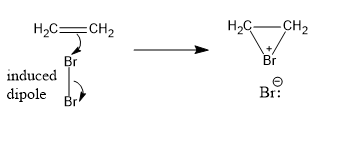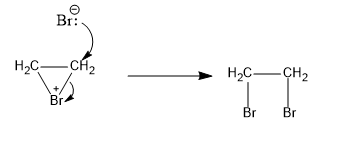
When ethene reacts with bromine, it forms
A) Chloroethane
B) Ethylene dibromide
C) 1-bromopropane
D) 1,2-dichloroethene
Answer
221.4k+ views
Hint: We know that ethene is the simplest of alkenes having one double bond. It is present in the gaseous state having a sweet flavour. And we know that bromine is a halogen of red-brown colour present in the liquid state.
Complete Step by Step Answer:
Let’s discuss the reaction of bromine with ethene. Ethene, when a reaction with liquid bromine, or with a bromine solution in tetrachloromethane which is an organic solvent, breaks the double bond of ethene and attaching of one bromine atom at each carbon takes place. Therefore, the product formed in this reaction is dibromo-ethane or ethylene dibromide. The chemical reaction is,
\[{\rm{C}}{{\rm{H}}_{\rm{2}}} = {\rm{C}}{{\rm{H}}_{\rm{2}}} + {\rm{B}}{{\rm{r}}_{\rm{2}}} \to \mathop {{\rm{Br}} - {\rm{C}}{{\rm{H}}_{\rm{2}}} - {\rm{C}}{{\rm{H}}_{\rm{2}}} - {\rm{Br}}}\limits_{{\rm{Ethylene}}\,{\rm{bromide}}} \]
Let’s understand the mechanism of the reaction. In the first step, the attachment of one bromine atom to both carbon atoms. And the bromine atom is positively charged.

Image: Formation of bromonium ion
In the second step, the attack of the bromide ion at the bromonium ion from the back side happens. The resultant product is ethylene dibromide. The reaction is:

Image: Formation of ethylene dibromide
Therefore, the reaction of ethene and bromine gives ethylene dibromide.
Hence, option B is right.
Note: The reaction of ethene and bromine is an electrophilic addition. The electrophilic addition defines an addition reaction of a nucleophile and an electrophile that causes the addition of a double or a triple bond. An electrophile defines a species that has a tendency to react with other molecules having a donatable electron pair.
Complete Step by Step Answer:
Let’s discuss the reaction of bromine with ethene. Ethene, when a reaction with liquid bromine, or with a bromine solution in tetrachloromethane which is an organic solvent, breaks the double bond of ethene and attaching of one bromine atom at each carbon takes place. Therefore, the product formed in this reaction is dibromo-ethane or ethylene dibromide. The chemical reaction is,
\[{\rm{C}}{{\rm{H}}_{\rm{2}}} = {\rm{C}}{{\rm{H}}_{\rm{2}}} + {\rm{B}}{{\rm{r}}_{\rm{2}}} \to \mathop {{\rm{Br}} - {\rm{C}}{{\rm{H}}_{\rm{2}}} - {\rm{C}}{{\rm{H}}_{\rm{2}}} - {\rm{Br}}}\limits_{{\rm{Ethylene}}\,{\rm{bromide}}} \]
Let’s understand the mechanism of the reaction. In the first step, the attachment of one bromine atom to both carbon atoms. And the bromine atom is positively charged.

Image: Formation of bromonium ion
In the second step, the attack of the bromide ion at the bromonium ion from the back side happens. The resultant product is ethylene dibromide. The reaction is:

Image: Formation of ethylene dibromide
Therefore, the reaction of ethene and bromine gives ethylene dibromide.
Hence, option B is right.
Note: The reaction of ethene and bromine is an electrophilic addition. The electrophilic addition defines an addition reaction of a nucleophile and an electrophile that causes the addition of a double or a triple bond. An electrophile defines a species that has a tendency to react with other molecules having a donatable electron pair.
Recently Updated Pages
JEE Main 2025-26 P Block Elements Mock Test – Free Practice Online

JEE Main Mock Test 2025-26: Chemical Bonding & Molecular Structure

JEE Main 2025-26 Biomolecules Mock Test – Free Practice & Solutions

JEE Main 2025-26 P Block Elements Mock Test – Free Practice

JEE Main 2025-26 Mock Test: D and F Block Elements Chapter

Atomic Structure JEE Main Mock Test 2025-26: Free Practice Online

Trending doubts
JEE Main 2026: Application Form Open, Exam Dates, Syllabus, Eligibility & Question Papers

Derivation of Equation of Trajectory Explained for Students

Hybridisation in Chemistry – Concept, Types & Applications

Understanding the Angle of Deviation in a Prism

How to Convert a Galvanometer into an Ammeter or Voltmeter

Degree of Dissociation: Meaning, Formula, Calculation & Uses

Other Pages
Solutions Class 12 Chemistry Chapter 1 CBSE Notes - 2025-26

NCERT Solutions For Class 12 Chemistry Chapter 1 Solutions - 2025-26

The D and F Block Elements Class 12 Chemistry Chapter 4 CBSE Notes - 2025-26

NCERT Solutions for Class 12 Chemistry Chapter Chapter 7 Alcohol Phenol and Ether

NCERT Solutions ForClass 12 Chemistry Chapter Chapter 8 Aldehydes Ketones And Carboxylic Acids

JEE Advanced Marks vs Ranks 2025: Understanding Category-wise Qualifying Marks and Previous Year Cut-offs




